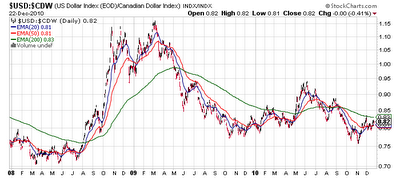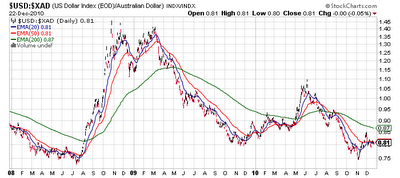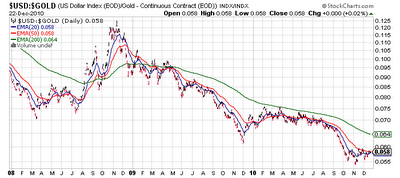December 23, 2010
There have been some interesting conversations on financial infotainment TV the past few days regarding the contention that the US dollar is actually quite stable, and people should stop complaining that the Fed is impacting it with debasement policies. The problem is, as with everything, things are not so simple.
There are 3 major currencies in the world -- dollar, yen, and euro. (One could throw the British pound in there if they are very lenient.) These are the most liquid currencies and hence easy for billions upon billions to slosh through at a moment's notice. They just so happen to reflect regions which are highly indebted, and whose central bankers have taken extraordinary steps to debase themselves to kick the proverbial can down the road. In short, we call this "the race to the bottom." All major currencies of the world are in an ugly duckling contest.
Further, the US dollar is the world's reserve currency - so in times of crisis, it is the least ugly, being the most liquid. (In many countries in Africa, or the Middle East, or Asia, or Latin America, you could go and exchange dollars in commerce -- not so much the yen or the euro for example.) So ironically, as the US was the nexus of the global crisis in 2008 and early 2009, a very strange thing happened. People fled into the country's currency (and bonds). That is completely atypical -- usually people flee the country at the center of the crisis, causing all sorts of havoc. So the US benefited greatly in terms of stability from concurrently being the cause of global crisis, yet having people flee TO it, rather than AWAY from it.
So when we view the dollar over the past few years versus the euro or yen (or pound) we are comparing mirror imagines of the US -- highly indebted, slower growth economies. (There are a few exceptions in Europe, but I am speaking broadly about the union.) Hence, to infer any "strength" by comparing the team who is ranked 30th in the NFL versus the team ranked 28th is silly - they both stink.
What we can do is compare the greenback versus countries whose fiscal house is viewed much more favorably -- even if their currency is less liquid on a global stage (and hence not a place trillions of money can slosh to in an instant).
US Dollar Versus Canadian Dollar
(Click to enlarge)
US Dollar Versus Australian Dollar
(Click to enlarge)
U.S. Dollar Versus Swiss Franc
(The spike in 2010 was due to the Greek crisis.)
(Click to enlarge)
(and as a bonus)
US Dollar Versus Non-Fiat Money (Gold)
(Click to enlarge)
What we see above is very consistent -- excluding the "flight to safety" trade in '08 and early '09, the loss of value in the dollar continues when compared to more prudent countries. (Or a currency with no liabilities -- gold) While the Fed and policy makers can defend themselves by saying the USD is "holding in there" when compared to the other major currencies -- all of which are running similar schemes to the US to try to self debase their currencies to "inflate" their way out of their massive debts -- it is certainly not shaping up well against countries in the next tier.
So is the dollar withstanding the actions of our policy makers? Only if your bar is extremely low - our drunken stupor is about equal to that of the Japanese, and Euro Union. And those currencies (along with the pound) make up the majority of the dollar index -- so things appear benign on the surface lately.
If however you compare said greenback to countries whose fiscal policies would be considered sensible, the story changes dramatically. Against that basket, our policy makers are slowly but surely eroding our wealth via inflationary theft... i.e. debasement of our currency and hence, our savings and/or ability to eventually consume. We're doing the same work, but being rewarded with a less valuable item in return. Another strike against the saver class of Cramerica and why the magical rise in the stock market in nominal terms means something very different than in real terms.




0 comments:
Publicar un comentario